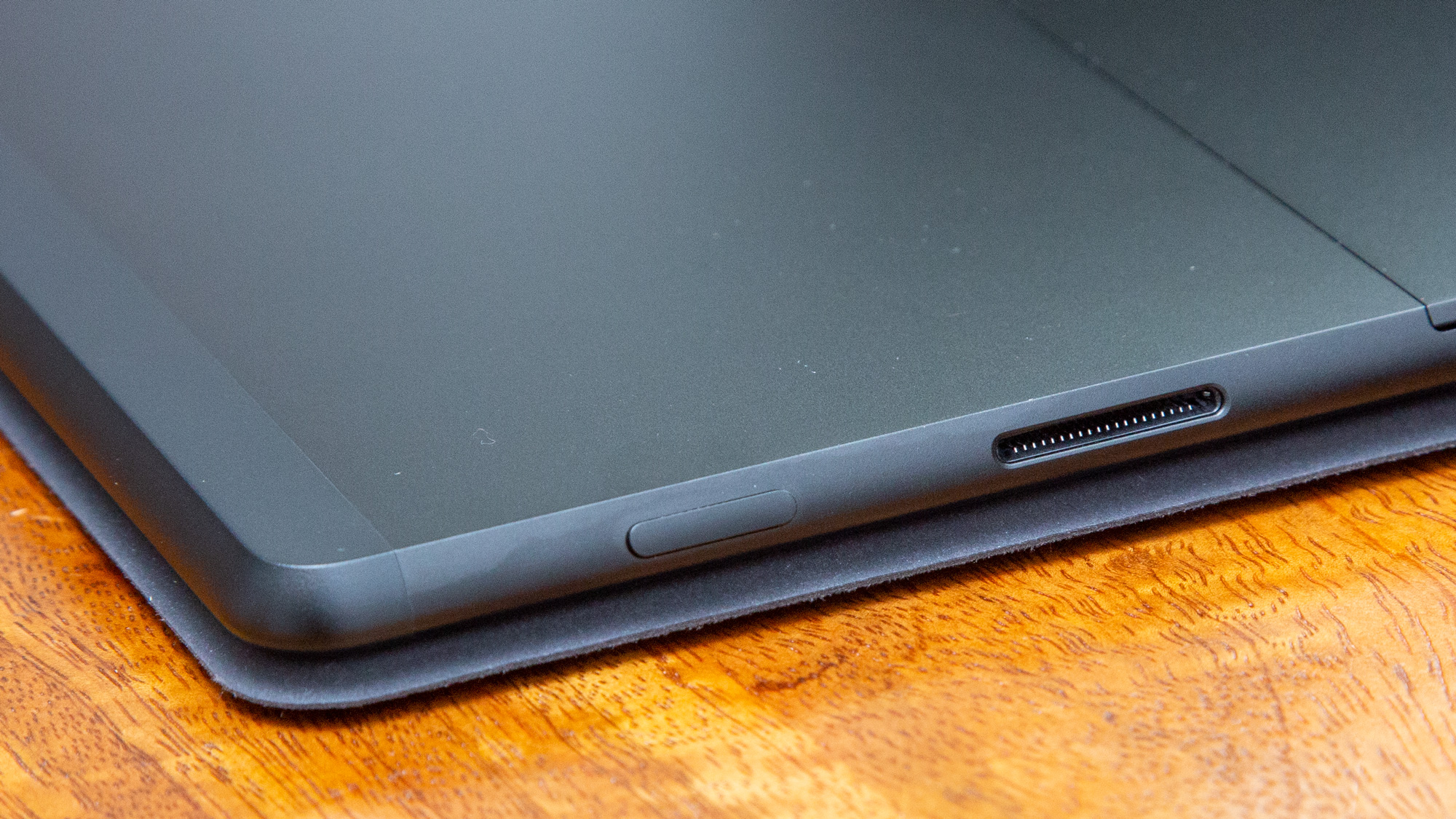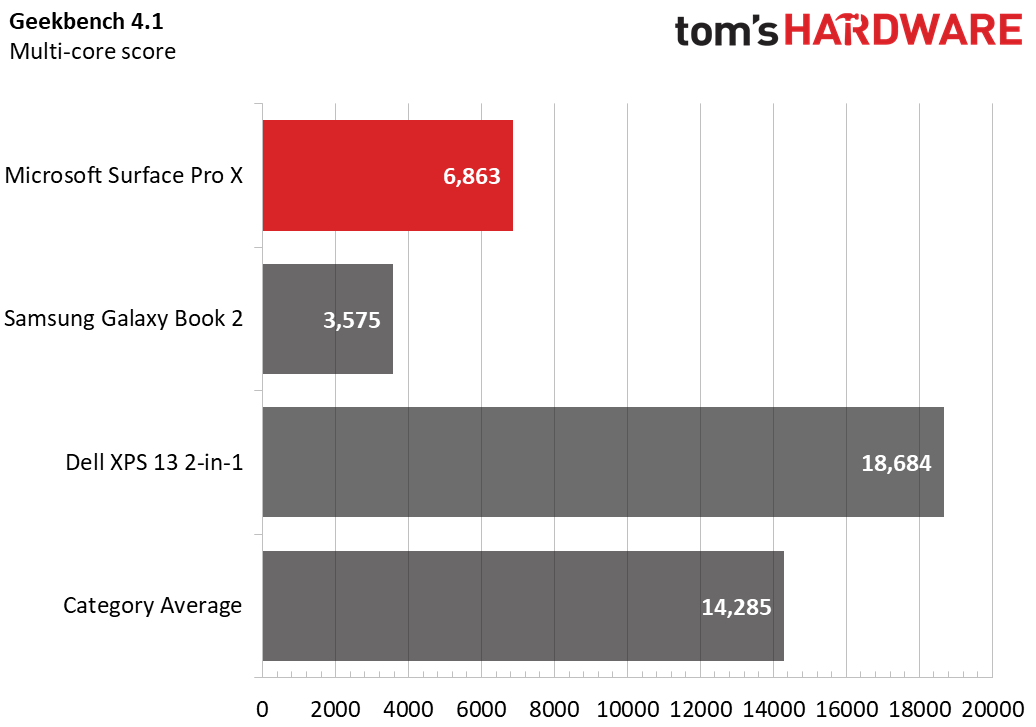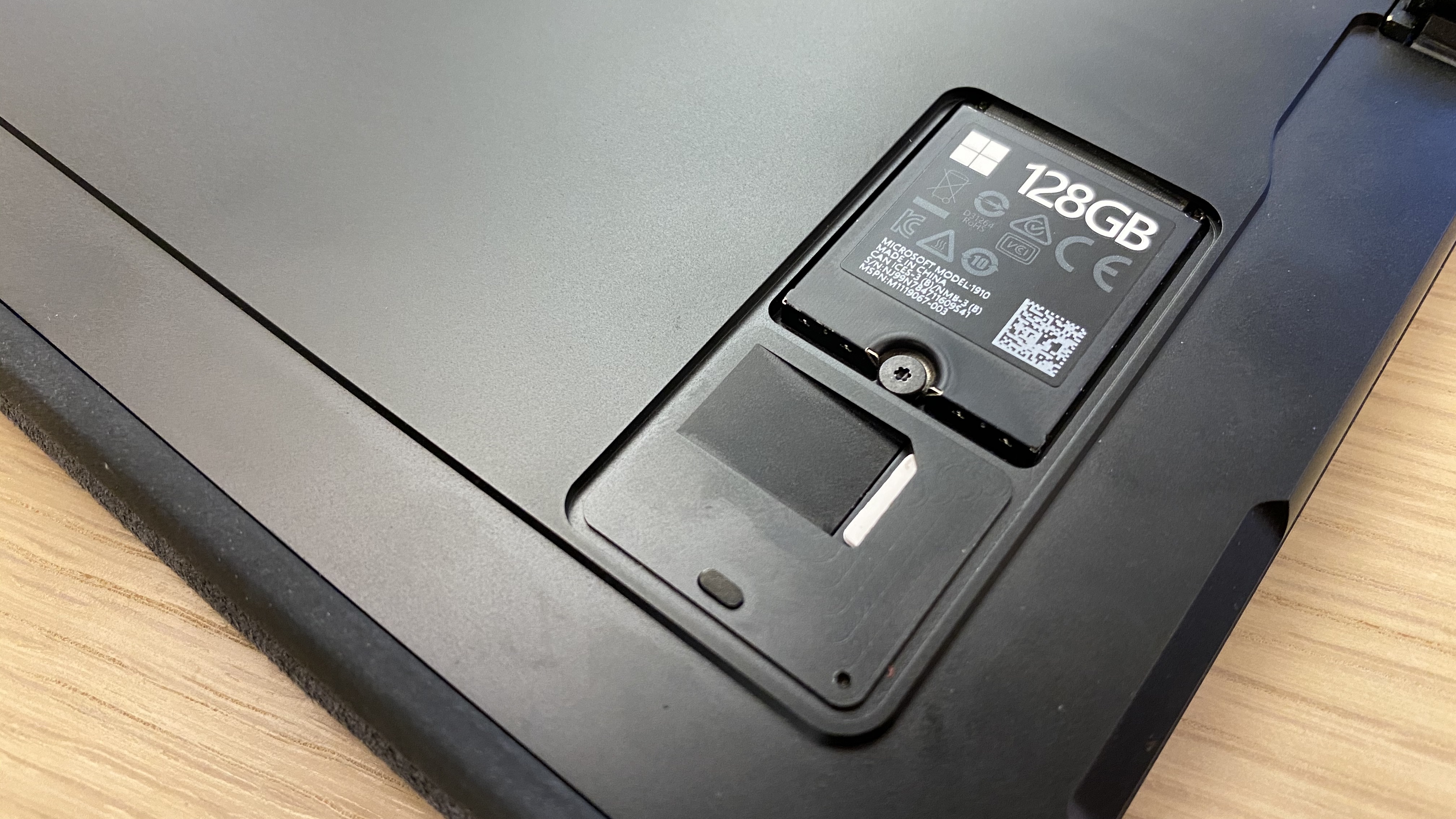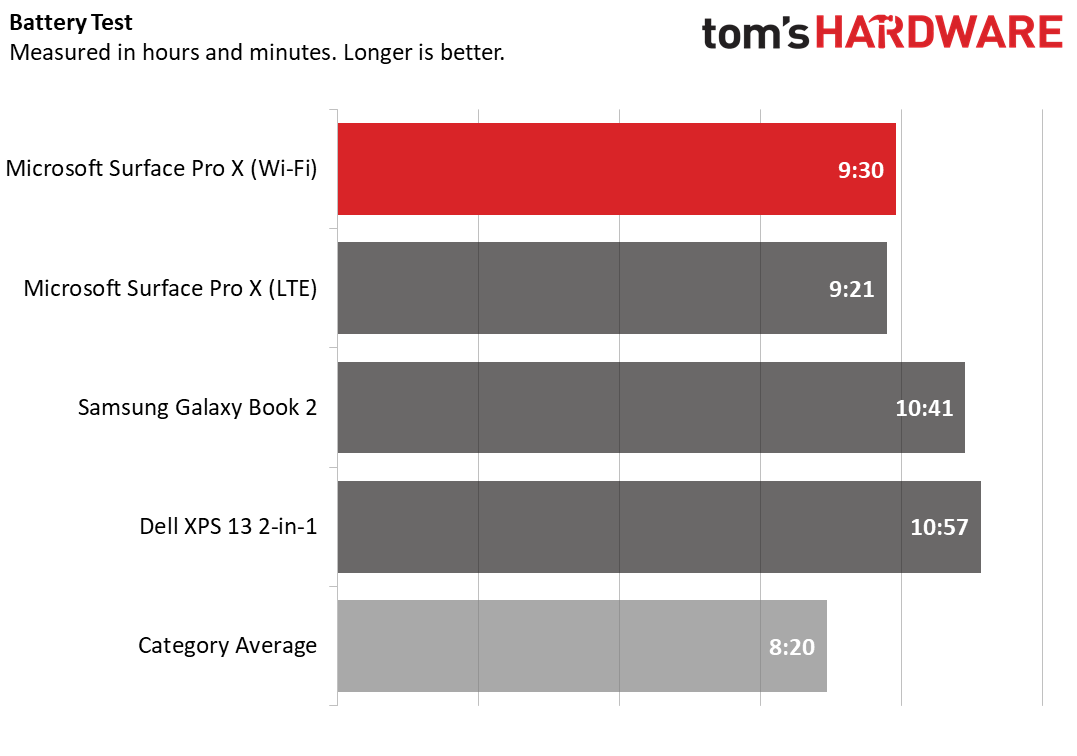Tom's Hardware Verdict
The Microsoft Surface Pro X is a beautiful piece of hardware, but it’s Windows 10 app compatibility issues and price make it hard to swallow.
Pros
- +
Gorgeous design
- +
Easily replaceable SSD
- +
Bright 3:2 display
Cons
- -
Serious app compatibility issues
- -
No headphone jack
- -
Too expensive
- -
Performance is so-so
Why you can trust Tom's Hardware
It’s a new era for the Microsoft Surface Pro. For the first time since the 2012-era Microsoft Surface RT, the company is back with an ARM design and LTE support. The Surface Pro X ($999.00 to start; $1,268.99 as tested) is a far cry from that memory, with full Windows 10 and a gorgeous slim design that's bringing a bit of the future to the Surface Pro. It’s also extremely easy to replace the SSD, which is great. But one (big) problem remains: app compatibility.
Design
The Surface Pro X is the most beautiful tablet I’ve ever held. Sure, it apes Apple’s iPads in some ways with its sleek rounded corners and thin bezels. But the matte-black anodized aluminum is sleek, the 3:2 aspect ratio is great for work and for holding the device, and the kickstand hinge, if you like a detachable 2-in-1 design, is flexible and offers just the right amount of resistance.





This is the design of Microsoft’s hardware future, and it makes the Intel's Ice Lake powered Surface Pro 7 look like a device from the past. This is the design I’d want to be seen out and about with.
But the aluminum on the Surface Pro X is a bit of a fingerprint magnet, so be sure to keep a cloth handy. On the back, besides a black-on-black Microsoft logo with a mirror sheen, there is no decoration at all.
We tested the tablet with Microsoft’s Surface Pro X Signature Keyboard with Slim Pen ($269.99 for the bundle of the two). The new pen is flat, and is more like a carpenter pencil than a pen (more on the functionality in the Keyboard, Touchpad and Stylus section below). And the keyboard, which is black with luxurious Alcantara fabric, has a spot for it. A little indentation on the top (which is hidden if you like your keyboard at an angle) serves as a wireless charging cradle for the stylus.
And this thing is super slim. It’s 11.3 x 8.2 x 0.3 inches (287 mm x 208 mm x 7.3 mm) and it weighs just 1.7 pounds (it gets heavier at 2.4 pounds with the keyboard). The Surface Pro 7, which is hundreths of an inch thinner, does feel noticeably thicker with the old design. The Surface Pro X is of a similar size to the Samsung Galaxy Book 2, which is 1.8 pounds and 1.3 x 7.9 x 0.3 inches.
If there’s one letdown in the design, it's the lack of ports. Because it’s a tablet, I don’t mind the fact that there are few connections, but the selection is odd. There are two USB Type-C ports on the left side, which is a huge improvement over prior Surface tablets that didn’t have this connector. I don’t mind the lack of a Type-A port. But the only port on the right side is Microsoft’s proprietary Surface Connect port for charging and using the company’s proprietary docking station. I would have preferred another Type-C port there.
Get Tom's Hardware's best news and in-depth reviews, straight to your inbox.
Perhaps the biggest omission is the lack of a headphone jack. Admittedly, many users may have gotten used to this as smartphones continue to ditch that port and move to Bluetooth headphones or USB Type-C dongles. Since this is a tablet I suspect that many will forgive it for lacking the port, but as a full Windows PC, it’s sorely missed.
A volume rocker lives on the left side of the machine, and the power button sits on the right.
Specifications
| CPU | Microsoft SQ1 |
|---|---|
| Graphics | Microsoft SQ1 Adreno 685 |
| Memory | 8GB LPDDR4X-3733 |
| Storage | 128GB |
| Display | 13-inch 2880 x 1920 with 3:2 aspect ratio |
| Networking | Qualcomm Wi-Fi B/G/N/AC (2x2), Qualcomm Snapdragon X24 LTE Modem |
| Ports | 2x USB Type-C; Surface Connect; nano SIM card slot; |
| Cameras | 5MP Front-facing; 10MP rear-facing; |
| Battery | 38.2 WHr |
| Power Adapter | 65W |
| Operating System | Windows 10 Home |
| Dimensions | 11.3 x 8.2 x 0.3 in (287 x 208 x 7.3 mm) |
| Weight | 1.7 pounds (2.4 pounds with Signature Keyboard) |
| Price (as configured) | $1,268.99 |
Windows 10 on ARM
For enthusiasts and many business users, considering the Surface Pro X will start and end with one question: Can it run the programs that I need?
The answer will depend on two factors: which programs you use, and how long you’re willing to wait.
The Microsoft SQ1 is an ARM processor, a custom chip based on Qualcomm’s Snapdragon 8cx. To run on this CPU right now, programs either need to be native ARM64 or ARM 32. Alternatively, it can emulate 32-bit x86 programs, but with a significant performance cost. If a developer offers an x86-32 version of your program, you’re in luck. But if only a 64-bit app is available, it won’t work.
Additionally, many third-party antivirus solutions won’t work (though Windows Security will), and many games have issues if they use certain versions of OpenGL (newer than OpenGL 1.1) or have anti-cheat drivers that don’t work with ARM.
That being said, there is development for Windows on ARM, but it’s slow going. Adobe, for example, has announced a version of its Fresco drawing and sketching app for Windows on ARM devices, but we don’t know exactly when it’s coming. Regular Dropbox doesn’t work, so if you use that for storage, you need to use the neutered “Dropbox for S mode,” which doesn’t store files on your device.
While Microsoft recently removed a number of apps from its store that don’t run on the system, a bunch of games - notably those on the company’s own Game Pass service, still remain.
Some popular programs do have native versions, like the popular media player VLC, Netflix, Twitter, Skype, and Windows Terminal. You’ll want those versions from the Microsoft Store. A new version of Edge is coming, and that will support ARM as well, but it’s a shock that Microsoft didn’t ship it alongside this flagship device. Mozilla has native ARM compatibility for Firefox in beta. Of those native apps that I tried, they were all swift. But you’ll have to see if your apps are supported or decide if there are alternatives you’re willing to use.
The emulation has improved year-over-year. In Google Chrome, for instance, I was able to run multiple tabs without much of an issue, except that it took a few seconds to switch between tabs. That happened much less in the beta version of Firefox.
Productivity Performance
The limitations of Windows 10 on ARM meant that several of our benchmarks didn’t work, but we ran what we could. We tested the base configuration of the Surface Pro X, with Microsoft’s SQ1 processor, 8GB of RAM and 128GB of storage. In general, the tablet worked OK with simple tasks like browsing the web and streaming video, but I did see some stuttering and occasional lockup even with light use. There were also some bugs. Occasionally, when using it on my desk, the “Autorotate on” notification would pop up in the top-right corner, despite me not attempting to rotate the device.

On Geekbench 4.1, the Surface Pro X earned a score of 6,863. That’s progress over the Snapdragon 850 in the Samsung Galaxy Book 2 (3,575), but far lower than the Dell XPS 13 2-in-1 with Intel’s Core i7-1065G7 Ice Lake chip. It should be noted here that this benchmark, like many others, is measuring performance over x86 emulation. But because so many apps rely on emulation, that’s not an entirely unfair comparison.

It took the Surface Pro X 32 seconds to copy 4.97GB of files, or 159 MBps. That’s faster than the Galaxy Book 2, but slower than the XPS 13 2-in-1.All the competing system were below the category average of 528.1 MBps.
Connectivity
Besides Wi-Fi, the Surface Pro X also supports Qualcomm’s Snapdragon X24 LTE Modem. The integration between Qualcomm’s ARM designs and its modem tech is one of the biggest advantages of using the SQ1 processor in the first place.
And considering how slim and light the Surface Pro X is, it makes sense for you to use it on the go. The tablet has a spot for SIM cards underneath the kickstand, which may be the best way for most to use it, at least in the United States. The Surface Pro X also works with eSIM, though U.S. carriers aren’t great at supporting it.
Display
I love the 13-inch, 2880 x 1920 display on the Surface Pro X. It may not outbenchmark its competitors on all tests, but it wins me over in two ways.
One: It has a 3:2 aspect ratio that’s ideal for work. I can see more of what I’m working on when I have a taller screen. Sure, there are black bars when watching video, but that doesn’t bother me too much.
Two: The thick borders from the regular Surface tablets have been greatly reduced here, which makes using the computer more immersive.
When I watched a trailer for Star Wars: The The Rise of Skywalker at 1080p, some greenery Rey runs through in the jungle didn’t pop as much against the brown soil as it did on other screens. But a yellow, powdery explosion in the desert stood out against the bright blue sky.
Microsoft’s panel covers 103 percent of the sRGB color gamut, which is lower than average (125 percent) and behind both of its competitors.

The screen is super bright, with an average rating of 448 nits. That’s higher than the premium laptop average (361 nits) and the Galaxy Book 2, though the XPS 13 2-in-1 reached an incredible 517 nits.
Keyboard, Touchpad and Stylus
The keyboard and Surface Slim Pen are sold separately. You can buy the Type Cover and Slim Pen separately, but we tested with the Signature Keyboard and Slim Pen bundle.
As with previous Surface devices, the keyboard connects magnetically to the bottom of the Surface. In the case of the Signature keyboard, there is an indentation above the keys to place the Slim Pen. The stylus is held in magnetically and charges wirelessly. (If you choose to buy the stylus separately, it comes with a USB Type-C charging cradle instead.)




The keys don’t have a lot of travel, but are comfortable enough, particularly for a type cover. There’s still a bit of bounce if you keep the keyboard at an angle, but it’s more solid when flat on a desk. I typed at a rate of 97 words per minute, which is lower than usual for me, but with a slight 2% error rate.
I really like the flat stylus, which surprised me at first. It has all of the best features of the original Surface Pen, including the ability to use the back as an eraser, pressure sensitivity, and, in certain apps, shading. And this version is rechargeable, which I feel is a huge upgrade over having to look for uncommon AAAA batteries.
Audio
Considering that this is a tablet, the front-firing speakers on the Surface Pro X do a solid job. When I listened to Lit’s “My Own Worst Enemy,” the guitars, vocals and drums were all crystal clear. But as with many laptops, the bass was lacking — in fact, in this case it was almost non-existent. There’s no preloaded audio software to help you make adjustments.
Upgradeability
This is the most easy-to-open Surface device ever. On the back of the tablet, beneath the kickstand, is a small door. That’s where the SSD and the SIM card slot are.

All you need to do to open the door is use a SIM card removal tool (or a bent paper clip) and it pops right off. There’s a single Torx screw holding the SSD down.
The Surface Pro X uses a 2230 M.2 SSD, which is shorter than most M.2 SSDs on the market right now. But that form is starting to become more popular, so there should be more options available soon.
Battery Life
You can definitely get a day’s use out of the Surface Pro X. On our battery test, which constantly browses the web, streams video and runs webGL animations over Wi-Fi at 150 nits, it endured for 9 hours and 30 minutes. That’s well over the premium laptop average of 8:20.

We also ran the test over LTE (we tested on Verizon’s LTE network), and it lasted for a similar amount of time: 9:21.
The Dell XPS 13 2-in-1, a much larger device, lasted for 10:57. The Snapdragon 850-based Galaxy Book 2 also lasted longer, at 10:41.
Heat

To test skin temperatures on the tablet, we ran a YouTube video for 15 minutes and took heat measurements on the back. The hottest point measured 42.8 degrees Celsius (109.4 degrees Fahrenheit). It’s not too hot to use as a tablet, but it would be better if it were slightly cooler when holding it. This isn’t a problem when using it with a keyboard on a desk.
Cameras
The Surface Pro X has two cameras: a webcam and a rear-shooting camera.

The 5MP front camera is the better of the two, with a resolution of 2592 x 1458, it takes sharp, color accurate photos. At my desk, in a challenging office environment, it accurately captured the blue, white and orange in my plaid shirt and caught details down to the thread. It also picked up the different colors in my beard.

The 10MP, 4064 x 2286 rear camera was a little less impressive. I took some pictures of a plant in my office and it caught the different shades of green. But the whole image was a bit cloudy, as if there was a film over it.
Software and Warranty
The only notable extra piece of preloaded software on the Surface Pro X is the Surface app, which lets you adjust pen pressure, check the battery level for Microsoft Bluetooth accessories and get quick links to support and warranty coverage.
Of course, Windows 10 still has a share of bloatware and links to Microsoft Store apps, including Netflix, Spotify, Candy Crush Friends, Farm Heroes Saga, Hulu and Disney Magic Kingdoms.
Microsoft sells the Surface Pro X with a one-year hardware warranty.
Configurations
We reviewed the base model of the Surface Pro X, which is $999 with a Microsoft SQ1 CPU, 8GB of RAM and 128GB of storage. But we also used the Surface Pro X Signature Keyboard with Slim Pen bundle, which costs $269.99. That brought the total to $1,268.99.
If we just wanted a keyboard, that would be $139.99 (or a total of $1,138.99), though that doesn’t have a wireless charging cradle for a pen and isn’t made of Alcantara. If you just want the slim pen, it’s sold separately for $144.99, so the total would be $1,1,43.99 with the base model with a USB Type-C cradle to charge the pen.
If you want both the Slim Pen and a keyboard, the bundle is the best bet, as it’s cheaper than buying the two separately and allows for wireless charging. Either way, note that you can’t get a full experience for the price it says you’re paying without accessories, unless you only want to use it as a tablet.
There are a few other configurations. For $1,299.00, a $300 markup, you can get the 8GB configuration with 256GB of storage. At $1,499 you get 16GB of RAM and a 256GB SSD. For $1,799, you get get 16GB of RAM and 512GB of storage (another $300 bump). Every configuration has the same display and Microsoft SQ1 processor. Whichever you get, calculate the price accordingly by adding the peripherals you plan on using.
Bottom Line
Using the Microsoft Surface Pro X is euphoric at first, but followed by a splash of cold water. You’re greeted with a bright, beautiful display on a lovely chassis, and, finally, USB Type-C. It has an ARM CPU, LTE support and runs full-on Windows 10.

But the app compatibility problem quickly becomes obvious. For casual users, this may never be a massive problem. But this isn’t just any Surface. It’s a Surface Pro, and it’s one that is priced like premium laptops and tablets that don’t have these issues. And using a half-assed version of Dropbox or a sluggish emulation of Chrome browser sure is an issue.
Support is on the way for more apps, but they’re not here yet, and it’s not clear how long users will be waiting, or if the developer community will pick it up in force. I can get over the lack of a headphone jack, but the Windows ecosystem of programs is wide, and the offerings for professionals and creators, who this is marketed to, aren’t all ready.
If you’re looking for a beautiful tablet, the pique of Microsoft’s hardware design, and you don’t want an iPad, this is for you. It works great as a solid portable computer, especially for browser and Office-based activities, with few hiccups, if you’re willing to go the extra mile and get the peripherals. For those, I could recommend it if money is no object. Otherwise, Intel or AMD alternatives, like the Surface Pro 7 with Intel’s Ice Lake processors, are better bets. The Surface Pro 7 is $899 ($100 less) when configured as closely as possible to the Pro X, before keyboard and stylus.
Microsoft and Qualcomm need more developer support, period. When that day comes, the Pro X could be special. But we're far from that point, and given the history of Windows on ARM, it's unclear if we'll get there during this latest round of devices, or if we still have years to wait before native app support is no longer spotty.
MORE: Best Gaming Laptops
MORE: Gaming Laptop Reviews
MORE: All Laptop Content

Andrew E. Freedman is a senior editor at Tom's Hardware focusing on laptops, desktops and gaming. He also keeps up with the latest news. A lover of all things gaming and tech, his previous work has shown up in Tom's Guide, Laptop Mag, Kotaku, PCMag and Complex, among others. Follow him on Threads @FreedmanAE and BlueSky @andrewfreedman.net. You can send him tips on Signal: andrewfreedman.01